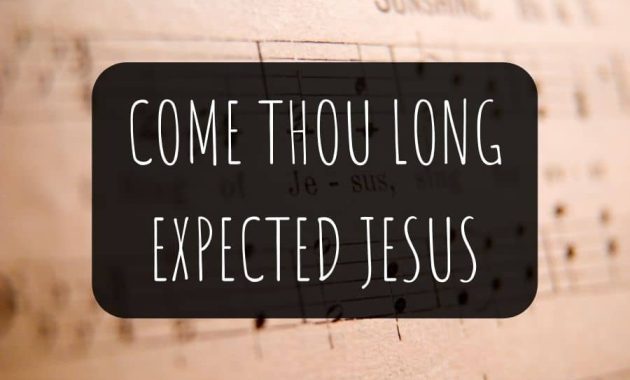Come Thou Long Expected Jesus
“Come Thou Long Expected Jesus” is a beloved hymn of hope and anticipation that has resonated with Christians for centuries. It reflects the deep longing for the arrival of the Messiah and the hope that Jesus’ coming has brought to the world.
In this article, we will explore the origins of this hymn, its biblical significance, and its contemporary relevance.
See also: What A Mighty God We Serve Hymn
Come Thou long expected Jesus Lyrics

- Come, thou long expected Jesus,
born to set thy people free;
from our fears and sins release us,
let us find our rest in thee.
Israel’s strength and consolation,
hope of all the earth thou art;
dear desire of every nation,
joy of every longing heart. - Born thy people to deliver,
born a child and yet a King,
born to reign in us forever,
now thy gracious kingdom bring.
By thine own eternal spirit
rule in all our hearts alone;
by thine all sufficient merit,
raise us to thy glorious throne.
Songwriters: Charles Wesley
Published by: Public Domain
The origins of “Come Thou Long Expected Jesus”
The hymn “Come Thou Long Expected Jesus” was written by Charles Wesley, the younger brother of John Wesley, who founded the Methodist movement. Born in 1707, Charles Wesley is known for his prolific hymn-writing, having penned more than 6,000 hymns in his lifetime. This particular hymn was published in 1744 in a collection titled “Hymns for the Nativity of our Lord.”
The historical context
“Come Thou Long Expected Jesus” was written during a time of significant social and religious change in 18th-century England. The Industrial Revolution was transforming the country, leading to urbanization, economic disparities, and social unrest. Amidst these challenges, the Methodist movement emerged as a spiritual revival, emphasizing the importance of personal faith and the transformative power of God’s grace.
Musical adaptations
Over the years, “Come Thou Long Expected Jesus” has been set to various tunes, with the most well-known being “Hyfrydol,” a Welsh melody composed by Rowland Hugh Prichard in 1830. This tune’s lilting melody and rich harmonies have made it a favorite among congregations, further enhancing the hymn’s emotional impact.
The Significance Of The Hymn
The role of Jesus as the Messiah
The hymn highlights the role of Jesus as the long-awaited Messiah, the one who fulfills the prophecies and promises of the Old Testament. Throughout the hymn, Wesley weaves biblical imagery and references, emphasizing the deep connection between the coming of Jesus and the hopes of Israel for a deliverer and king.
The anticipation of His return
While the hymn primarily focuses on the first coming of Jesus, it also alludes to the anticipation of His second coming, when He will return to establish His eternal kingdom. This aspect of the hymn serves as a reminder for Christians to maintain a sense of hope and longing for the ultimate fulfillment of God’s promises.
The Contemporary Relevance
Spiritual longing
“Come Thou Long Expected Jesus” remains a powerful expression of spiritual longing in the modern world. Just as the hymn spoke to the hearts of those in the 18th century, it continues to resonate with people today who are seeking hope, purpose, and meaning in a world that often feels chaotic and uncertain.
Hope in troubled times
The message of “Come Thou Long Expected Jesus” offers a beacon of hope in troubled times, reminding us that Jesus is the ultimate source of comfort, peace, and salvation. As we sing this hymn, we can find solace in the knowledge that God is with us, working to bring about His redemptive purposes in our lives and in the world.
Personal reflection
The hymn encourages personal reflection on our own anticipation of Jesus’ presence in our lives. As we sing the words “Born to set Thy people free,” we are invited to consider the ways in which we need to experience freedom, healing, and transformation through Christ.
Come Thou long expected Jesus FAQs
Who wrote the hymn "Come Thou Long Expected Expected Jesus"?
Charles Wesley, the younger brother of John Wesley (the founder of the Methodist movement), wrote the hymn "Come Thou Long Expected Jesus."
When was "Come Thou Long Expected Jesus" written?
The hymn was written in 1744 and published in Charles Wesley's collection "Hymns for the Nativity of our Lord."
What is the main theme of "Come Thou Long Expected Jesus"?
The main theme of "Come Thou Long Expected Jesus" is the longing for the arrival of the Messiah, Jesus Christ, who brings hope, deliverance, and redemption to the world.
What tune is commonly associated with "Come Thou Long Expected Jesus"?
The most well-known tune for "Come Thou Long Expected Jesus" is "Hyfrydol," a Welsh melody composed by Rowland Hugh Prichard in 1830.






